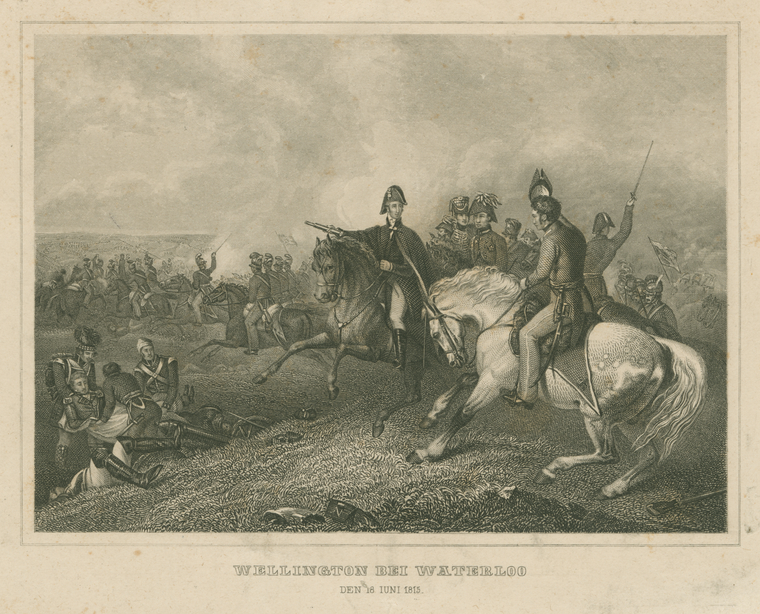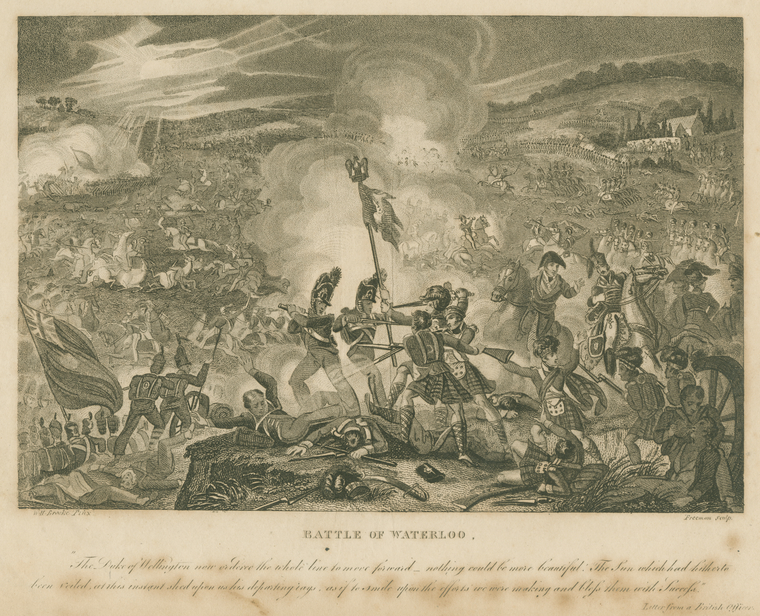The Longest Afternoon: Looking Back on Waterloo
Waterloo 200 has inspired some interesting books recently to help mark the signature passing of this noteworthy event in European history. Among the many aspects of this complex event. a few stand out. The gallant defense of the Chateau/farm known as Le Haie Sainte (named after the Savior perhaps) was one of the pivotal defensive positions the Duke of Wellington had chosen. As a master of the tactical defense, the Duke chose a number of key strongpoints to serve as breakwaters against the massive French assaults that he expected Napoleon to launch upon his line in order to break through to Brussels and win the campaign.
He entrusted this key position to the 2nd Light battalion of the King's German Legion (KGL). We should take a moment to describe who these particular Germans were. When the Electorate of Hanover (a minor German princely state) was overrun by the Napoleonic French in 1803- 04 the remnants of that old Royal army fled abroad. Because of past connections to the English Crown (George III was a descendant of the ruling House of Hanover in England) a special force of émigré Germans known as the King's German Legion was formed to fight along with the British army against Napoleon. This they did with great professionalism through the Iberian Peninsula Campaign with the Duke winning many laurels in both Portugal and Spain. Wellington considered them among his best troops as they combined German professionalism with English grit and determination. A powerful combination.
As a Light battalion they were adept at skirmishing and were not limited to the close order tactics of the line troops. They were also armed with the first mass produced rifle of that time. The Baker Rifle which was effective at 200-300 yards. All of these elements made the 2nd Light KGL uniquely suited to defend a Chateau like La Haie Sainte. Today the Chateau continues to run as an active farm and remains as a living monument to the events of June 18, 1815.
On that day the 360 men of the 2nd Light KGL under colonel Baring found themselves placed at the farm. They had already fought a battle, marched through soaking rain and had endured a sleepless, wet night. Like all the participants before the battle of Waterloo they were exhausted and fearful of what the day would bring. They would find themselves at the very epicenter of the day’s events.
In The Longest Afternoon: The 400 Men Who Decided the Battle of Waterloo, the author does a convincing job at giving us many individual stories of the men who comprised this small unit and what some of them had to say about the fight in their memoirs. He narrates the battle as it unfolds around the farm almost hour by hour. The first French assault of the day upon the center of Wellington's line came close to breaking it, and the élan of that assault nearly carried Le Haie Sainte as well. But the unexpected counter-attack by Lord Uxbridge's British Heavy Cavalry threw a wrench into Napoleon's plans and retrieves the situation. Thereafter the French never regain their energy as they mount a series of bloody, uncoordinated assaults. Gradually it occurs to Napoleon that La Haie Sainte is the lynchpin to Wellington's center. To pry it open it must be taken. Later Napoleon believed that an entire Division of 5,000 must have defended the farm. Not just a mere 400 odd men!
The French continue to throw themselves at the position with almost reckless abandon. The author believes close to 2,000 French casualties must have been sustained as the KGL riflemen could hardly miss the close packed French column assaults. Finally by six o:clock Colonel Baring knew the end had been reached. Down to less than half their original number, the Germans are also low on ammunition. The special Baker Rifle required its own ammunition. The wagon for this had been displaced somewhere during the previous day's retreat to Waterloo. It was nowhere to be found. Suddenly the brave defenders were faced with the prospect of fighting without bullets and with just bare hands, clubbed muskets and bayonets. The French proceed to climb on top of the farm and shoot down into their mass in the courtyard. It becomes a slaughter for both sides as men grapple with each other hand to hand in very close proximity. Baring's men can't last for long under these circumstances, and despite efforts to reinforce them earlier the farm has become an isolated bastion by days end. True to their form, the Germans are professionals. Not fanatics. They have fought to the point where they can no longer. Colonel Baring decides to fight his way out of the farm and back to the ridge with the remnants of his battalion. Only 46 survive from the original 360, although more turn up by nightfall. While they finally had to relinquish their key position, its gallant defense all afternoon contributes significantly to Wellington's eventual victory over Napoleon at day's end. With Prussian intervention coming by nightfall Napoleon has fought and lost his last battle.
Branden Simms has created an inspired work which provides a detailed look at how a small unit conducted itself in this period under extreme duress. His book is not only a military history, but a look at the actual people who took part in these events. He chronicles their lives on an almost hourly basis and we endure with them those momentous events that took place on that sultry afternoon 200 years ago on a small Belgian field. That farmland and structures remain active to this day which are owned by individuals aware of their historical significance. The author was privileged to know the current owner of La Haie Sainte and was able to spend actual time in the Chateau doing the research for this book. This is a fast paced work, which reads almost like a novel. Those wanting to see a famous, world changing event like waterloo from an intimate, human perspective should certainly find this fine work worthwhile. The defense of Le Haie Sainte is still admired and studied today by military academies. It remains one of the epic Last Stands in history.
Read E-Books with SimplyE
 With your library card, it's easier than ever to choose from more than 300,000 e-books on SimplyE, The New York Public Library's free e-reader app. Gain access to digital resources for all ages, including e-books, audiobooks, databases, and more.
With your library card, it's easier than ever to choose from more than 300,000 e-books on SimplyE, The New York Public Library's free e-reader app. Gain access to digital resources for all ages, including e-books, audiobooks, databases, and more.
If you don’t have an NYPL library card, New York State residents can apply for a digital card online or through SimplyE (available on the App Store or Google Play).
Need more help? Read our guide to using SimplyE.


Comments
Book Review of The Longest Afternoon
Submitted by Marykym (not verified) on August 22, 2015 - 4:46pm